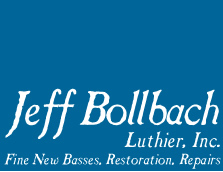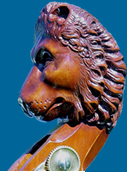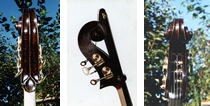|
|
|
|
|
|
IMAGES
Restoration | Repair
| Fine New Basses
|
RESTORATION
Here are some pictures of the aforementioned Italian bass's scroll. Actually, the bass came to me without an original scroll. I had to come up with something so I decided to pull out all the stops. I carved a copy of a late 18th century Northern Italian scroll without a neck. I then varnished it as new and began the aging process. First, I drilled three holes as if it were a three string bass. I had broken gears and worms from that period and used them to wear the head as natural. I then plugged the holes,two poorly-the third nicely. Four holes were drilled, re-bushed and re-located several times as would naturally occur. All along other techniques were employed to age the scroll. I learned a lot from my friend Oded Kishony, an expert on the subject. He taught me how to induce varnish cracking in a convincing manner. Oded also showed me how to add colors to refine the process. If you want to add black, it's a simple matter right? Not exactly. All "black color" is not the same, different materials that appear black refract light in different ways. What is the "black" on an instrument? For the most part it is lampblack, after all how were buildings lit and heated 150-200 years ago? This substance would constantly precipitate in that environment and cover instruments. They would be cleaned and polished over the years and it would accumulate. It was easy to make lampblack and apply it judiciously. The result was very convincing. The final step was in grafting the scroll. I did this in such a manner as to make it look like it was done decades ago. I believe the end result would have fooled anyone without access to carbon dating. Of course I told the buyer that it was a new scroll.
|


| 359 Miller Avenue, Freeport, NY 11520 (516) 867 1395 · jbollbach17@gmail.com |
| [Directions to the workshop] |
|
4
 |
||



